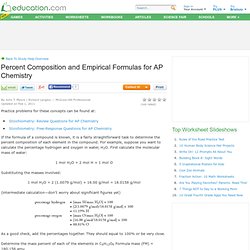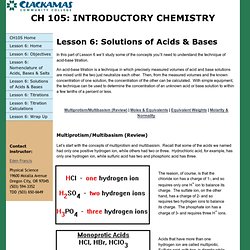

Chapter 4, Section 6. Chemical Reactions and Stoichiometry. CHEM101%20Final-Exam%20Solutions. CHE 120 - Packet 5. CHE 120 - Packet 5Nitro Compounds chemical reactionproductsreactantsbalancepotential energykinetic energyenthalpyexothermicendothermicactivation energycatalystmoleAvogadro's numbermolar massstoichiometrykinetic molecular theoryAvogadro's Lawcombustionexplosionnitro group, –NO2guncotton (nitrocellulose)gunpowderpara-nitrotoluenepara-aminobenzoic acid, PABAdinitrotolueneTNT, trinitrotoluenedynamite, nitroglycerintrinitrophenol/picric acidammonium nitratePETN, pentaerythritoltetranitratenitric oxideanginadilation a.

You should understand how a chemical equation represents a chemical reaction and be able to interpret a chemical equation for a chemical reaction. b. You should understand and be able to define and use the terms reactant and product. c. D. E. Stoichiometry Calculator. General Chemistry: Principles, Patterns, and Applications 1. Stoichiometry Videos - General Chemistry Tutorials & Lectures. About this chapter Chemistry: Stoichiometry 'Stoichiometry' is a big, imposing word that simply refers to a branch of chemistry that looks at chemical reactions, or processes that transform substances into other substances.

It's concerned with what goes into a reaction (the reactants) and what comes out (the products). Its applications are basically everywhere, even if you don't realize it - for example, how does your body sustain itself off the food you eat and the air you breathe? How do scientists manufacture drugs to cure diseases? Understand how to read and write a chemical equation Make calculations involving moles, mass, gases and solutions See how to maximize reactions by analyzing ideal yields Pick out the different substances in a chemical compound. Percent Composition and Empirical Formulas for AP Chemistry. Practice problems for these concepts can be found at: If the formula of a compound is known, it is a fairly straightforward task to determine the percent composition of each element in the compound.

For example, suppose you want to calculate the percentage hydrogen and oxygen in water, H2O. Lessons Worth Sharing. TED-Ed LESSONS 110,194 Views There are over one billion cars in the world right now, getting people from point A to point B.... 107,195 Views How did the periodic table of elements revolutionize our understanding of the world?

What... 64,253 Views Vinegar may have a powerful smell, but did you know it's actually a weak acid? 163,168 Views Salt dissolves in water; oil does not. 13,904 Views In a CSI age, we take forensic science for granted. Ch105: Lesson 6 Solutions of Acids/Bases. In this part of Lesson 6 we’ll study some of the concepts you’ll need to understand the technique of acid-base titration.

An acid-base titration is a technique in which precisely measured volumes of acid and base solutions are mixed until the two just neutralize each other. Then, from the measured volumes and the known concentration of one solution, the concentration of the other can be calculated. With simple equipment, the technique can be used to determine the concentration of an unknown acid or base solution to within a few tenths of a percent or less. Multiprotism/Multibasism (Review) | Moles & Equivalents | Equivalent Weights | Molarity & Normality.
Chem20.wikispaces. Leggett PAP Chemistry 2-9 Dimensional Analysis. Conversion-Factors-684. M = V × ρ or mass = volume × density (1) Taking the density of gold from a reference table, we can now calculate This is more than 18 lb of gold.

At the price quoted above, it would be worth over 40 000 dollars! The formula which defines density can also be used to convert the mass of a sample to the corresponding volume. If both sides of Eq. (1) are multiplied by 1/ρ, we have Notice that we used the mathematical function D = m/V to convert parameters from mass to volume or vice versa in these examples. An Important Caveat 20 g x = 200 cm3 It is only possible to calculate the volume of gold if the density of the alloy is known, so that the volume of alloy represented by the 20 g could be calculated.
The bottom line is that using a simple unit cancellation method does not always lead to the expected results, unless the mathematical function on which the conversion factor is based is fully understood. Solution The volume of 100 g of solution is V = m / D = 100 g /0.96923 g cm-3 = 103.17 cm3. Fun with Dimensional Analysis.
Dimensional analysis (also known as the factor-label method or unit-factor method) is by far the most useful math trick you'll ever learn.

Maybe you've learned some algebra, but will you use it? For many people the answer is, "not after the final exam. " For a fraction of the effort needed to learn algebra, you too can learn "dimensional analysis. " First off, however, let's get rid of the big words. What this is all about is just conversion—converting one thing to another. This trick is about applied math, not about numbers in the abstract.
Example 1 How many seconds are in a day? First, don't panic. Here's your first problem: 1. 2. All of these statements, or conversion factors, are true or equivalent (60 seconds = 1 minute). 3. Remember that you want to know: